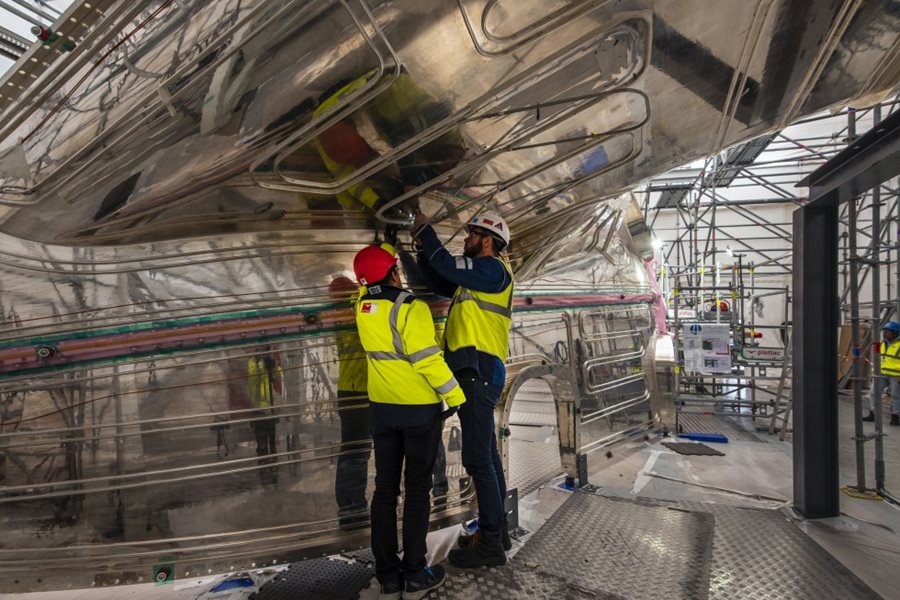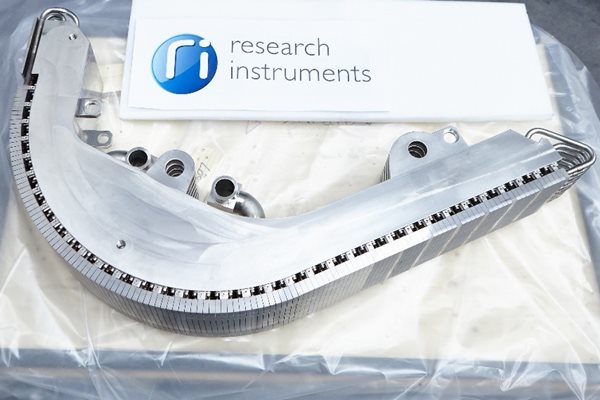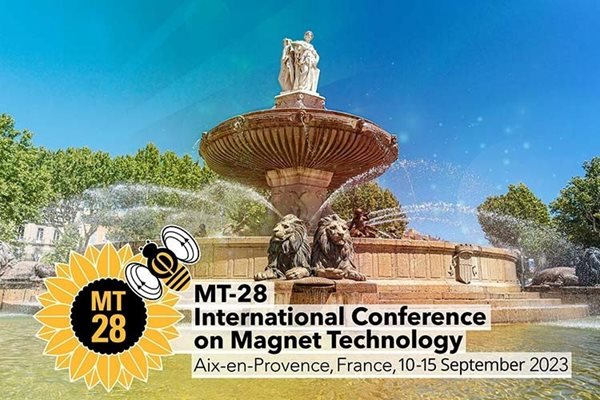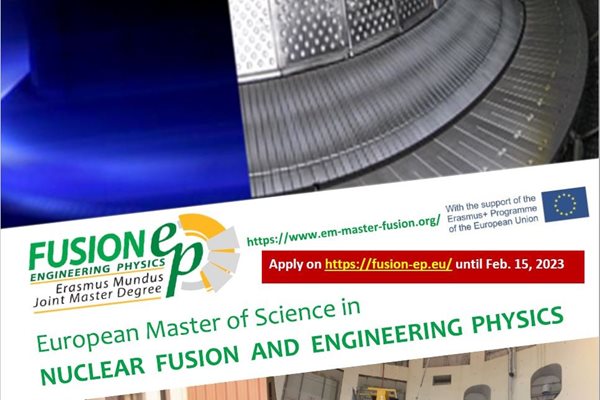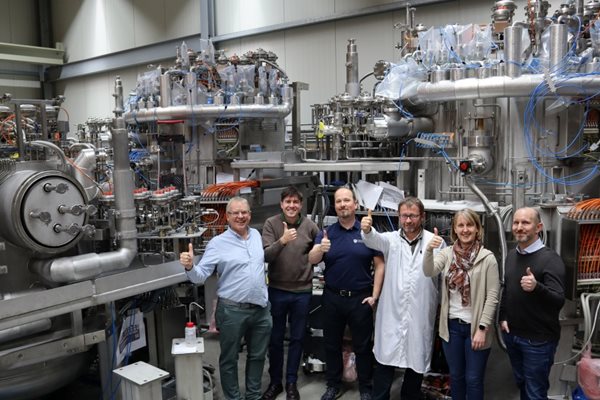
you're currently reading the news digest published from 19 Dec 2022 to 09 Jan 2023
featured3
of-interest3
image1
press37
featured
Component repair | A clear picture is emerging
Under a vast plastic tent set up in the Cryostat Workshop, workers in protective gear are busy cleaning the surface of a thermal shield panel that has been stripped of its cooling pipes, with the last traces of welds removed. A short distance away, in the Assembly Hall, other workers are assembling the platform used to support the 440-tonne vacuum vessel sectors during the preparation phase prior to their installation in vertical tooling. These two activities are the only visible evidence, so far, of the intense work performed over the past few months, and especially in the weeks preceding the end-of-year break, to define a repair strategy for the ITER Tokamak's thermal shield panels and vacuum vessel sectors. Two and a half years into its machine assembly phase, ITER is facing challenges common to every industrial venture involving first-of-a-kind components. 'There is no scandal here,' says ITER Director-General Pietro Barabaschi. 'Such things happen. I've seen many issues of the kind, and much worse...' The defects identified in two key components, the thermal shield panels and the vacuum vessel sectors, can and will be fixed. In-house and external experts have identified the causes and explored different repair options and strategies. Although details remain to be worked out with the contractors that will be chosen to execute the repairs, a clear picture is now emerging. As reported in late November, the issue with the thermal shield panels is one of 'stress corrosion cracking' that is affecting the cooling pipes welded to the component surface. In the course of the manufacturing process, chlorine residues were trapped in tiny pockets near the welds, causing cracks up to 2.2 millimetres deep. The problem was identified on three, yet-uninstalled vacuum vessel thermal shield panels. (There are two outboard panels and one inboard panel for each of the nine vacuum vessel sectors, or 27 panels in all.) 'When you find three instances of cracks, it is a red alarm because there could be hundreds of locations where cracks could develop,' says Barabaschi. The decision was taken to remove and replace all cooling pipes (23 kilometres in total) from the panels and to choose a solution that would exclude the risk of stress corrosion cracking. But a question needed to be answered first: would the removal of the pipes alter the panels' dimensions, rigidity, or their capacity to accommodate a new set of piping? The ongoing activity under the big white tent inside the Cryostat Workshop is all about answering these questions. As for the pipes themselves and their attachment process, different solutions have been explored. 'We looked at quite a number of different options,' explains ITER Tokamak Assembly Specialist Brian Macklin. 'In pipe fabrication, we will use a different steel formulation—more resistant to corrosion. For joining the pipes to the panels we contemplated using clamps rather than welds, but concluded that welding was still best, provided we use a lower-energy process and slightly different welding wire.' Who will execute the repairs and where are still open questions. 'We hope to launch the tender in the first week of February and have a contractor by the end of March, which is very fast by our standards,' says Macklin. Discussions with the selected industrial partner will determine whether the components are repaired on site or in an outside facility. There is also a strong possibility that 'a few' panels will be re-manufactured. 'This option might actually be cheaper than repairing them,' says the ITER Director-General, 'and in any case I prefer to have a few spares.' The ITER management is making the assumption that the crack issue in the cooling pipes could be systemic, affecting all thermal shield components—including the lower cryostat thermal shield, which has already been installed. Due to the difficulty of lifting the component back out of the crowded environment of the assembly pit, it has been decided to leave the original cooling network in place, disconnect it, and attach a new set of pipes to replace it. The other component issue that the ITER Project is addressing relates to the dimensional non-conformities discovered in the three vacuum vessel sectors that have already been delivered. (One of these sectors forms the core of the 'module' which is already in place in the assembly pit.) Vacuum vessel sectors are among the most massive components of the machine, as high as a five-storey building and as heavy as an Airbus A380. D-shaped vacuum vessel sectors are formed from four segments welded together. It is during this welding process that deviations from nominal dimensions occurred in different locations on the sectors' outer shells. These deviations were more important than the specified limit and modified the geometry of the field joints where the sectors are to be welded together in the Tokamak pit, thus compromising the access and operation of the bespoke automated welding tools. Schematically (very schematically...), valleys must be filled and hills must be shaved in order to restore the geometry to nominal and recover the ability to weld the sectors together. 'Machining is best; depositing metal is a bit more risky,' says Macklin. 'We will need to combine both options, and we are tailoring the solution as best as we can. Repairs will only start once the build-up process has been fully qualified.' The quantity of filler material anticipated is not insignificant: approximately 73 kilos for sector #6 (the one already installed in the assembly pit), 100 kilos for sector #1(7) and 400 kilos for sector #8, the most affected of the three. Considering the importance of the vacuum vessel as the ITER installation's first nuclear safety barrier, an approved notified body, acting on behalf on the French nuclear regulator ASN (Autorité de sûreté nucléaire), is closely involved in the technical discussions on repair options. The weld deposition process is currently being qualified, and the deposited material will be subject to 100 percent non-destructive examination by either radiography or ultrasonic testing. 'We are pursuing a very aggressive schedule to perform molten metal deposition tests on 'coupons' provided by the manufacturer, to carry out welding simulations at our industrial partner ENSA, and of course to select contractors in order to have everything ready to go in June.' Repairing the three steel behemoths will require complex logistics: sector #8, presently installed in one of the sector sub-assembly tools, will be lifted out and placed in a horizontal position on the platform currently being assembled at the opposite end of the Hall, then moved to another building where repairs will be executed. The operation, scheduled for April, will require a reverse use of the upending tool so that it can 'down-end' the 440-tonne component. Sector #1(7) will remain where it is in tooling, and be stripped of its thermal shield panels to prepare for repairs. Sector #6 will take the place of sector #8 on tooling after the module it belongs to is lifted out of the Tokamak pit—an operation planned in late May or early June. Sector #6 will have to be disassembled from its toroidal field coils and thermal shield panels, so that the vacuum vessel sector is ready for repair in late 2023. The duration and cost of the repairs cannot, at this stage, be precisely estimated. 'A substantial amount of time is required, and time always costs money,' says Director-General Barabaschi. 'But we can take advantage of the present situation to reorganize and increase the experimental content of the operational phase and reach full-power operation—our real and final objective—with minimum delay.'
In memoriam | Andrei Serafimovich Kukushkin
The ITER Organization remembers Andrei Serafimovich Kukushkin. In the midst of the festive season, the ITER Organization learned with deep sadness of the passing of Dr. Andrei Serafimovich Kukushkin, former staff member in the ITER Science Division and seminal contributor to the physics design of one of most important components of the ITER tokamak, the divertor. In fact, it would be no exaggeration to refer to our cherished colleague as the father of the ITER divertor physics basis as we know it today. After a courageous fight against pancreatic cancer throughout the latter part of 2022, a fight which typified his attitude in life, Andrei passed away on 24 December in Moscow, the city where he was born on 11 December 1946 and to which he returned following his retirement from the ITER Organization. His family moved soon after his birth to the city of Ivanovo, about 300 km northeast of Moscow, where he attended school before returning to Moscow to complete his education at the prestigious Kolmogorov Internat, a specialized highschool for mathematically gifted children from all over Russia. He was then admitted to the equally illustrious Lomonosov Moscow State University for graduate studies. From there followed employment at the Kurchatov Institute where, in the 1980s, he began his first foray into the area of tokamak plasma boundary physics, developing one of the very first edge plasma transport simulation codes, and setting him on a trajectory which was to define the rest of his scientific career. Involved in the Soviet Union contribution to the International Tokamak Reactor (INTOR), Andrei was part of the very first international cooperation on nuclear fusion which began in 1978, then consisting of only four partners (the European Atomic Energy Community, Japan, USSR and USA). He then became a member of the USSR physics team which continued work on the design of an international fusion experiment, baptized ITER in 1987, and made periodic visits to Garching, Germany, where design activities were underway. Following completion of these conceptual engineering studies, Andrei moved permanently to Garching at the beginning of 1993 to join one of the three Joint Central Teams responsible for the ITER Engineering Design Activity, conducted under the auspices of the IAEA. Once the formal agreement to build ITER was signed in November 2006, he moved to Provence, becoming one of the original members of what was then the Fusion Science and Technology Department in the nascent ITER Organization. Throughout the entire ITER design activities, right up to his departure from the ITER Organization, Andrei was the leading figure in the simulation of the ITER divertor performance. This component, situated at the bottom of the ITER vacuum vessel, must deal with about 90% of the 100 MW of thermal plasma power which will be continuously exhausted during baseline burning plasma operation. Simultaneously, it plays the role of reducing the influx of impurities released by plasma-material interactions into the hot core plasma and creates the conditions of high neutral gas pressure adjacent to the divertor plasma region, permitting the helium particles produced by the fusion reactions to be pumped away. Without this impurity retention and helium pumping, the core plasma purity would be insufficient for the burn to be sustained. In turn, by determining particle exhaust, the divertor also constrains the input fuel throughput and hence the specification of the entire ITER fuel cycle. As with many things on ITER, the divertor component will be the largest, most complex and expensive of its kind ever constructed. It must function as expected for ITER to reach its mission goals. Quite a responsibility, then, for the physics design, and the ITER Organization is fortunate indeed to have had such a dedicated, high quality physicist and computational scientist as Andrei Kukushkin prepared to devote a large part of his career to the task. Over the past 25 years, he collaborated with many colleagues, both inside and outside the ITER Organization, and performed meticulous and complex numerical simulations (each one can take months of wall clock time to complete) to explore and optimize ITER divertor design. His principal tool was the SOLPS code suite, which has become as a result the workhorse for this kind of simulation at the ITER Organization and of which he was the undisputed master. The tremendous library of simulations he accumulated, and the vast array of scripting tools he developed to allow the output of these code runs to be managed and the physics they produce to be explored, have provided, and continue to provide, an enormously important resource both for ITER Organization staff and physicists within the fusion institutes of the ITER partners. His work is fully documented in an impressive collection of articles published in the scientific literature. Much of Andrei's legacy may also be found in the very significant development of SOLPS which the ITER Organization has undertaken, along with external collaborators, in recent years. The latest major upgrade of the ITER version of this code, SOLPS-ITER, was released in just the last few weeks, with two dedicated workshops held in Europe and the USA to accompany the launch. Back in Moscow after half a lifetime devoted to the ITER design, Andrei remained extremely active, splitting his time between the Kurchatov Institute and the National Research Nuclear University (MEPhI), where he continued his research on tokamak plasma boundary physics and contributed to Russia's planned tokamak reactor projects. He was still co-authoring scientific articles to the very end; the last paper with lifelong colleague and friend from his first years at the Kurchatov Institute, Sergei Krasheninnikov (now Professor of Plasma Physics at the University of California, San Diego, USA) was published on 6 December 2022 in the journal Physics of Plasmas. He was also regularly exchanging scientifically with many colleagues around the world during his last months, including with the author of this tribute, to whom he sent a detailed response to a question on one of his favourite topics ('bifurcations in divertor plasma solutions') just a few weeks before his death. Andrei will be remembered by all the very many of us who had the good fortune to be counted amongst his friends and colleagues as the archetypal larger-than-life character—an exceptionally kind-hearted and gifted analytic and computational scientist, passionate and always ready to listen and advise. He never sought positions of authority and was content simply to do, and be left alone to do, good science. None of us will forget his deep baritone (he was a bass singer in his university choir) or infectious laughter, and all benefitted in some way from their interactions with him, both from the human and scientific perspective. He will be very sadly missed.
Divertor inner target | Europe launches manufacturing
Fifty-eight inner vertical targets—one for every divertor cassette body (54) plus four spares—will be manufactured under the procurement responsibility of the European Domestic Agency. Positioned at the intersection of magnetic field lines at the bottom of the ITER machine where particle bombardment is particularly intense, these challenging components have undergone a lengthy manufacturing qualification phase. Now, the German firm Research Instruments has been awarded a contract for the first series of 13. The plasma-facing components of the ITER divertor—the inner vertical target (Europe), the outer vertical target (Japan), and the dome (Russia)—will be exposed to a heat load that is ten times higher than that of a spacecraft re-entering Earth's atmosphere (10-20 MWm²). Tungsten, a shiny, silvery-white refractory metal that has a high melting temperature (3400 °C), will armour these plasma-facing components. For the inner vertical target, the maximum expected temperature on the tungsten surface will be about 1000 °C in normal operating conditions and 2000 °C in off-normal conditions. During a lengthy manufacturing qualification program, the European Domestic Agency, Fusion for Energy, worked with a number of suppliers to ensure competition and mitigate technical risks through the development of different technologies. After the successful fabrication and testing of small-scale (~1/20th) tungsten monoblock mockups mounted around cooling channel, three companies—the AES Consortium (Ansaldo Nucleare, Ansaldo Energia, and SIMIC), Alsymex, and Research Instruments—were able to qualify full-scale prototypes. Among the most difficult challenges encountered were the procurement of tungsten monoblocks, the bonding of the monoblocks to the copper alloy cooling tubes, the fabrication of the steel support structure, and strict dimensional requirements. In a major milestone that heralds the start of manufacturing, a first contract has been signed with Research Instruments for the production of 13 inner vertical targets. See the full story on the Fusion for Energy website.
of-interest
Reminder: Submit your abstract for MT-28
The 28th International Conference on Magnet Technology (MT-28) will be held in Aix-en-Provence, France, during the week of 10 to 15 September 2023. Abstract submission is open through 20 February 2023. For the first time in four years, the MT-28—the international forum for magnet-related technology and design—will bring participants together in person. The conference offers all participants increased networking opportunities and interactive sessions. The lead areas of the scientific program are fusion, high-energy physics, power engineering and medical diagnosis. In addition to plenary debates we offer opportunities for exchanges with industries and for career management. An industrial exhibition, an active program for students, as well as opportunities to visit the nearby ITER site will round out the event. Don't miss this opportunity to submit your abstract now! The MT-28 Local Organizing Committee (mt28@iter.org)
Apply now to the FUSION-EP Master's program
Applications are open through 15 February 2023 for the next wave of the FUSION-EP Master's program (September 2023 start). Scholarships are available to top-ranked candidates. The ideal candidate has, or is in the process of obtaining, a Bachelor's degree or recognized equivalent (minimum 3 years of study, 180 ECTS or more) in physics or engineering (nuclear, materials, chemical, electrical). Students from all countries can apply. The program language is English. The FUSION-EP program aims to train the next generations of magnetic confinement fusion physicists and engineers. It offers high-level, multinational, research-oriented education in fusion-related engineering or physics in close relation to the research activities of the partners, including the ITER Organization. More information about the program can be found on the dedicated website. To apply, click here.
See the 2022 IAEA survey of fusion devices
The International Atomic Energy Agency (IAEA) has just released its 2022 worldwide survey of public and private fusion devices that are currently in operation, under construction or in the planning stages. The publication, which lists just over 130 devices/projects, is intended to complement and further elaborate on the IAEA's online database, the Fusion Device Information System (FusDIS). Together, they provide a global overview of fusion research and development activities from the perspective of device capabilities. Download the pdf of the "World Survey of Fusion Devices 2022" or order a printed copy at this address.
